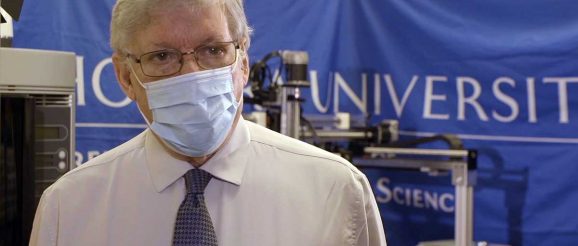Engineering Professor Wins First Zarb Innovation Grant – News | Hofstra University, New York

A professor from the Fred DeMatteis School of Engineering and Applied Sciences has been awarded the first-ever Innovation Research Fellow Grant from the Institute of Innovation and Entrepreneurship at the Frank G. Zarb School of Business for his work on the development of an autonomous wound closure system.
Dr. Edward H. Currie, associate professor of engineering, is leading a team of eight engineers, doctors, and students developing a robotic, fully-autonomous system that would be capable of identifying, assessing, and effectively closing wounds, such as lacerations, without the need for human operator.
The Innovation Research Fellow Grant program was created as part of a gift from Hofstra University Board of Trustees member Dr. Leo A. Guthart, after whom the Zarb School of Business’ newest building, Guthart Hall for Innovation and Discovery, is named. The grant program established a five-year initiative to promote research and teaching across the University and fund projects with commercial, educational, and societal impact.
“Dr. Currie’s project embodies the combination of scholarly research and entrepreneurship that this grant was designed to support,” said K.G. Viswanathan, interim dean of the Zarb School. “We’re excited to see where he and his team take their research in the future.”
The project, which has been underway for over three years in a joint venture with Northwell Health, uses artificial intelligence to plot topographic point cloud scans of the skin’s surface, detect the edges of the wound, and produce programmable magnets that pulls the edges of the wound together.
This manner of treatment promotes healing and naturally reduces scarring by keeping the edges flush and bound without the use of sutures or stitches. Because the system does not require a doctor or health care provider to operate, the autonomous system could save lives in underserved or war-torn regions of the world that do not have ready access to medical services, Currie said.
“This is a tough problem and there’s a need for a solution to it,” said Dr. Currie. “It’s clear the benefits are many and well known, not the least of which is the reduction of the risk of infection and scarring. It’s far reaching – this is opening the door to the next phase and we intend to continue to pursue this and go into the body to do internal procedures like biopsies.”
The research team includes four students who are charged with producing solutions to some of the most important challenges, such as improving the artificial intelligence program to better detect edges and working with augmented reality programs so the procedures can be observed in real time by an operator if the situation calls for it.
“Working on projects like this affords us an opportunity to get students involved with research in a meaningful way,” said Dr. Currie. “It’s important to get them exposure and get them excited about something, and having the opportunity to work on a project with world-wide implications is very exciting.”
The grant (approximately $23,000) provided by the Innovation Research Fellow Grant will assist Currie’s team in acquiring a high-resolution 3D video camera and ultrasound equipment that will help account for the movement of a patient in detection of the edges of the wounds and allow for accurate placement of the closing fixtures.
“We are very grateful to the Institute of Innovation and Entrepreneurship for selecting Dr. Currie as the first recipient of this grant,” said Sina Rabbany. “With this support, we will be able to focus on advancing our research on the autonomous wound closure system.”
